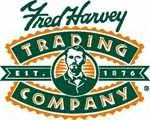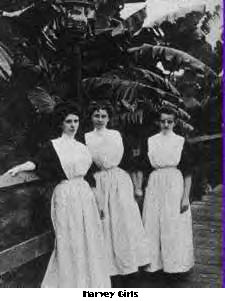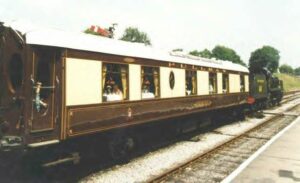In Search of a Decent Meal
by Jim Herron
After attending a party last year given by members of our train club in which they prepared dishes from recipes found in railroad cookbooks, I thought it might be interesting to talk about railroad cuisine.
Surprisingly, there are a number of books on the subject, four of which I’ll be writing about: Dinner in the Diner by Will E. Hollister, Dining by Rail, the History and Recipes of America’s Golden Age of Railroad Cuisine by James D. Porterfield, Chesapeake and Ohio Dining Car Recipes, compiled by E. Sterling “Tod” Hanger, Jr. and, my favorite, The Harvey House Cookbook, Memories of Dining Along the Santa Fe Railroad, by George H. Foster and Peter C. Weiglin.
It was impossible to find a decent meal on a rail trip west of the Mississippi before 1876. There were no dining cars and the average length of time for stops was twenty minutes to replenish the locomotive’s water supply at “tank towns.” The offerings were frequently slim to none. That was changed by the man who did a great deal to civilize the American West — Fredrick Henry Harvey. His Harvey Houses provided good food and charming service by Harvey Girls all cross the Santa Fe Railroad line until the advent of the dining car. Some eating houses were known to be quite good. Station eating houses, especially those along the western railroads, were glorified by travel journalists. The eating house experience survived for nearly sixty years.
A sample Fred Harvey dinner menu from 1888 included the following, all for the price of 75 cents! Blue Point Oysters on the Halfshell, Whitefish Filets with Madeira Sauce, Potatoes Francaise, Young Capon with Hollandaise Sauce, Roast Sirloin of Beef Au Jus, Pork with Applesauce, Stuffed Turkey, Cranberry Sauce, Mashed Potatoes, Boiled Sweet Potatoes, Sugar Corn, Salmi of Duck, Queen Olives, Baked Veal Pie, Charlotte of Peaches with Cognac Sauce, Prairie Chicken with Current Jelly, Sugar Cured Ham, Pickled Lamb’s Tongue, Lobster Salad, Beets, Celery, French Slaw, Apple Pie, Cold Chantilly Custard, Mince Pie, Cakes, Ice Cream, Bananas, Oranges, Grapes, Edam and Roquefort Cheese, Water Crackers, and French Coffee.
Eventually, as railroad technology improved and as mechanical and power advances enabled increased train speeds and longer operating distances, pressure on the railroads mounted to find some method for providing meals on the train itself. The successful evolution of dining cars gradually and, in some cases abruptly, caused the demise of the track side eating establishments. In 1868 George Pullman (of sleeping car fame) rolled a luxurious new car out of his shop that was dedicated exclusively to preparing and serving food to passengers. Chicago gets the credit for being the inaugural point of dining car service. The technological evolution of dining cars and their acceptance as a fact of life by the railroads was more or less complete by the end of the nineteenth century.
A sample menu from the Pullman Dining Car “Alhambra” leaving New York on January 18, 1888 includes all of the following for $1.00: Mock Turtle Soup, Consomme Victoria, Salmon a la Chamborg, Parisienne Potatoes, Boiled Beef Tongue, Boiled Chicken with Egg Sauce, Roast Been with Browned Potatoes, Roast Leg of South Down Mutton with Currant Jelly, Young Turkey with Cranberry Sauce, Fricendeau of Veal a la Richelieu, Salmi of Duck a la Jardiniere, Banana Fritters with Port Wine Sauce, Roast Saddle of Antelope with Currant Jelly, Lobster with Mayonnaise, Lettuce Salad, Spanish Olives, Celery, Chow Chow, Pickled Onions, Girkins, Boiled and Mashed Potatoes, Baked Sweet Potatoes, Stewed Tomatoes, Squash, French Peas, Succotash, Mince Pie, Apple Pie, Cocoanut Pudding, Fruit, Cakes, Ice Cream, Roquefort and Edam Cheese, Bent’s Crackers, Cafe Noir. The practice of offering a fixed price to cover an entire meal was known as the American Plan. This did not, however, last long. Rising costs, especially as World War I approached, made this approach — also known as table d’hote — impractical. By 1916 dining on most American trains was from an a la carte menu.
A sample menu from the Los Angeles Limited in 1943 reflects the scaled-back approach to food service: Shrimp Cocktail or Chilled Tomato Juice or Onion Soup Au Gratin with entree selections of Broiled Halibut ($1.20), Omelette with Fruit ($1.15), Beef Casserole ($1.40) or Roast Loin of Pork with Apple Sauce ($1.35), Potatoes O’Brien, Seasonable Vegetables, Avocado and Grapefruit Salad with French Dressing, Raisin Bran Muffins, Grapenut Custard Pudding, Kadota Figs, Ice Cream, Roquefort Cheese, Coffee, Tea, Milk and Cocoa.
The passing years found the ornate finery of dining cars giving way to more simple furnishings and decor. There was more emphasis on seating capacity and efficiency of operation. Dining cars also became larger as the years passed. Standard diners were 72 feet long in the ‘20’s and accommodated 36 passengers. By 1950 they reached a length of 85 feet. A staff of eleven manned the dining car.
Railroads developed pride in their dining car menus, which in turn attracted travelers from all over. Many railroads produced dishes related, in many ways, to the territories served, adding to the pleasure of the journey, as well as appeasing the appetites of the travelers. Dishes such as chicken gumbo offered on the Southern Pacific, southern corn cakes with syrup on the Southern line, barbequed lamb on Union Pacific and the Chesapeake Bay fish dinner on the Chesapeake & Ohio Railway introduced travelers to regional cuisine. Unfortunately, with the advent of Amtrak, the dining car as we knew it came to an abrupt end due to operational costs and manpower. They were replaced by snack cars with vending machines selling sodas, sandwiches and candy. Yes, they still do serve hot coffee!!
So, another part of American railroad history has faded quietly into the history books. The great recipes served during the Golden Age of Railroading still survive and many cookbooks can be found to tempt the palate, as some of us have already experienced.










